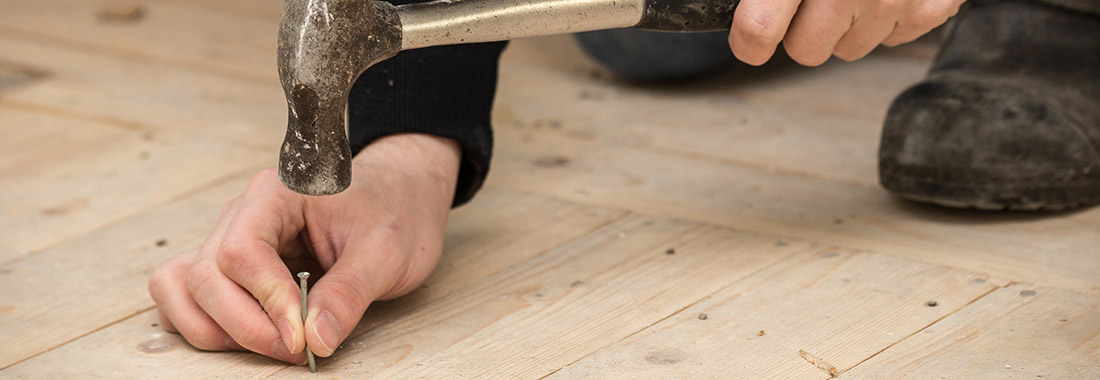

Nails rank among the simplest of all fixings and accessories found in the average toolbox. Nevertheless, it’s worth considering a few pointers from the pros, in order to ensure you know exactly when and how to use nails both appropriately and efficiently.
What are nails?
Nails are by far the simplest and most convenient fixing available for fastening two pieces of wood together. They’re designed and manufactured in an extensive range of sizes, shapes and specifications, though their basic purpose remains similar in most formats.
The vast majority of nails are made of steel, but it’s also possible to pick them up in a variety of other materials – aluminium, brass, zinc, copper and stainless steel. Galvanised nails offer maximum durability and resistance to both rust and corrosion, significantly boosting a nail’s lifespan.
As with most categories of tools and accessories, some nails are designed for a range of tasks, while others are manufactured with a very specific purpose in mind.
Types of nails
There are various different types of nails for different applications. Many of which can be used for a variety of different jobs around the home and garden. Just a few of the most common categories you’ll find from UK hardware retailers include:
- Clout – for fixing window sash cords and slates
- Felt nail/large-head clout – slightly shorter for securing roofing felt
- Cut floor brad – feature a rectangular cross section for fixing floorboards to joists
- Masonry nails – designed specifically to secure wood to masonry
- Oval wire nails – designed specially to reduce the risk of the wood splitting
- Panel pins – very small and slim for various carpentry applications
- Headless pins – suitable for thin veneers where large gauge nails might split the wood
- Plain-head wire nails – also referred to as a general purpose nail
- Plasterboard nails – features a jagged shank for additional grip
If you’re unsure which type of nail best suits your requirements, speak to your retailer before ordering.
Nails or screws?
There will always be projects and repair jobs where you’ll have the choice of using nails or screws. However, it’s important to remember that nails and screws have their own unique advantages and disadvantages, which should be taken into account before making your choice.
Ultimately, deciding between nails and screws comes down to an important trade-off: Grip Strength Vs. Sheer Strength
Grip strength refers to the capacity for a fastener to ‘pull’ two pieces of wood together. When comparing the two fasteners, screws are naturally able to create a tighter bond between the two surfaces, as you’re able to twist them into place until the connection is practically flawless. Screws can also significantly reduce the risk of the surfaces coming apart, which makes them particularly suitable for jobs such as laying wooden decking.
By contrast, sheer strength refers to the amount of force that the fastener can endure from the sides. In this respect, screws are surprisingly brittle and can easily snap when subject to extreme force from either side. Hence, when attaching joists to a deck frame, it would be far better to use nails rather than screws.
How to use nails (properly)
The basics of hammering nails into place are very simple. Assuming you have already selected the right shape, size and type of nail you need, the rest of the process is straightforward.
Nevertheless, you’ll find working with nails easier and produce much better results by keeping the following tips and points in mind:
Choose the right hammer
It’s essential to choose the right hammer for the job. A standard curved-claw hammer of a decent size will get the job done in most instances. There are also various specialty hammers to consider for other types of projects. Examples of which include tack hammers, ball peen hammers, mason hammers, mallets and drywall hammers.
Always protect your eyes
You can never predict when a hammer is going to fire off sharp pieces of shrapnel, which is why it is of the utmost importance to wear suitable protective googles at all times.
Hold the nail correctly
Don’t make the common mistake of holding the nail right at the bottom where it meets the wood, as doing will guarantee trapping your fingers if you miss the nail head. Instead, hold the nail near the top and you’re far less likely to injure yourself.
Take your time
Take your time with the first few taps to secure the nail in first. Starting out too aggressively can compromise the quality and accuracy of your swing. Save the force for the final hit, rather than attempting to drive the nail in too quickly.
Try blunting the tips
If you find that your nails keep splitting the wood as you drive them in, try slightly blunting the tips beforehand with your hammer. It’s a little known tip that can be surprisingly effective, which often eliminates problematic splitting of the wood.



